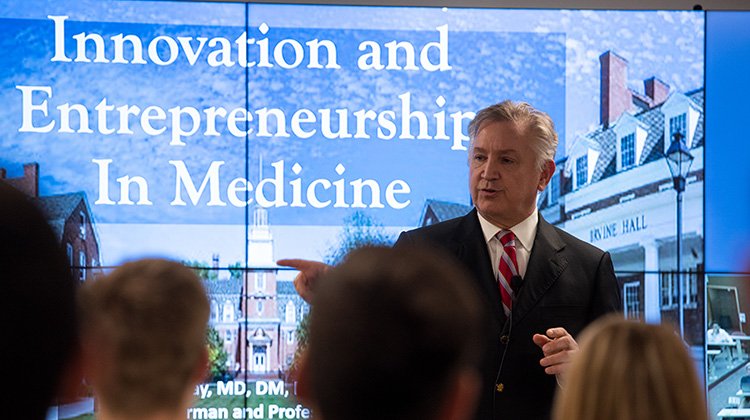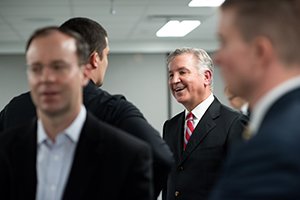World-renowned plastic surgeon and alumnus shares expertise with OHIO medical students

Dr. Frank Papay, chair of the Dermatology and Plastic Surgery Institute at the Cleveland Clinic, delivers a lecture titled “Innovation and Entrepreneurship in Medicine” at the Ohio University Heritage College of Osteopathic Medicine’s Cleveland Campus. Photo by Dustin Franz
When Dr. Frank Papay, BA ’75, is gearing up for a major surgery or procedure, he has a trusted ritual he uses to get in the zone.
He listens to “Stand Up and Cheer.”
On his path to becoming a world-renowned plastic surgeon and dermatologist, Papay attended numerous schools—including Ohio University, Case Western Reserve University and Northeast Ohio Medical University—but he identifies as a Bobcat first and foremost.
“I have a certain affinity for Athens,” says Papay, chair of the Dermatology and Plastic Surgery Institute at the Cleveland Clinic who graduated from OHIO’s College of Arts and Sciences in 1975 and was presented the OHIO Alumni Association’s Medal of Merit in 2016. “To this day, when I go back to OU, I viscerally feel different. The memories and emotions physiologically affect me.”
On Feb. 7, Papay got the chance to reconnect with OHIO in a different way: giving a lecture to medical students at the Cleveland Campus of the Heritage College of Osteopathic Medicine. He spoke on “Innovation and Entrepreneurship in Medicine,” a topic he knows well as the surgeon behind several face transplants and the holder of 24 medical device patents.

Dr. Frank Papay visits with Heritage College of Osteopathic Medicine students following a lecture he delivered Feb. 7 at the Cleveland Campus. Photo by Dustin Franz
Last September, Papay made global headlines for his work with Katie Stubblefield, the youngest person to ever receive a face transplant at 21 years old. National Geographic documented Stubblefield’s three-year journey—and stunning transformation at the hands of Papay and other Cleveland Clinic doctors—in a spread titled “Story of a Face.”
He shared the lessons of that experience with fellow Bobcats during his lecture and hailed OHIO mentors such as Rush Elliott, BA ’24, esteemed professor and dean emeritus of the College of Arts and Sciences, whom Papay used to take long walks with daily.
“When I was in medical school, being an entrepreneur was a four-letter word,” Papay told the crowd of approximately 50 students, along with audiences at the Athens and Dublin campuses via videoconference. “People think you need to distinguish between an entrepreneur and a doctor, and I think that’s terribly wrong. [Practicing medicine should be] a blend of innovation and entrepreneurship.”
It’s not surprising that Papay is an idea person—after all, he used to collect light bulbs as a kid, and he spent his childhood gleaning inspiration from inventors like Thomas Edison and Nikola Tesla, and space explorers like Neil Armstrong.
As an adult, his bright ideas have led to patents on a new surgical approach to treat migraine headaches, which earned him the honor of being one of WebMD’s “Health Heroes of 2014,” and a next-gen implant to treat sleep apnea. He’s also developing another device that uses augmented reality to help doctors differentiate between various tissues.
“When Neil Armstrong came home to Wapakoneta, I got to shake his hand,” remembers Papay of his childhood idol. “I grew up in the county just outside of Oberlin, so when I saw that he grew up in a farm town and could land on the moon, I thought, ‘Maybe I can do something.’”
Papay advised the students on the necessity of mentorship, best practices for mitigating risk, and the importance of being a “Tigger in a field of Eeyores.”
“Surround yourself with people smarter than you,” Papay told the students. “Collaboration leads to greater innovation. If you’re the smartest person in the room, you’re in the wrong room.”
